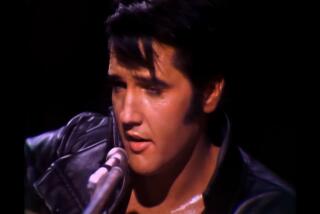ART : TV Exhibits Give Good Reasons to Use the ‘Off’ Button More : ‘Off the Air and Behind the Screen,’ on view through next Sunday at the Fullerton Museum Center, shows how television empowers people--and imprisons others.
FULLERTON — More than a month ago, friends loaned me a cassette of the first installment of the TV serial “Twin Peaks,” assuring me it really was pretty special. Well, they called recently and asked what I thought, and I had to admit that I never got around to seeing it.
Fact is, I just don’t keep the TV plugged in. A tiny little thing with a squint-sized screen, it sits almost invisibly on the floor of my study. (When I finally gave in six years ago and bought it, after living without a set since my high school days, the salesman--resting his bulk against a mammoth, wood-encased mega-model--assumed it would be “for the kitchen, of course!”)
When people swear they really don’t watch TV, listeners are liable to suspect a barefaced lie, or else conjure up feats of willpower akin to keeping a quart of Haagen-Dazs in the freezer for an entire day. But frankly, while I’m making my way through a stack of magazines and barreling through the book of the week, it never seems to occur to me that there might be something worthwhile to watch on the tube.
All this is by way of explanation that maybe I’m not the best person to be reviewing “Television: Off the Air and Behind the Screen,” which closes next Sunday at the Fullerton Museum Center. But I enjoyed the exhibit’s irreverence and thoughtfulness, and I’d hate to think it might not be drawing audiences right up to its final day.
The exhibit has three parts. The straightforwardly informative poster exhibit from the Smithsonian Institution is typical fare for the 3-year-old Fullerton museum. But the separate installations by Harry Shearer--a Los Angeles journalist/director/actor/media personality--and Boston artist and writer Richard Bolton suggest that the museum might find a great niche for itself by packaging critical treatments of popular subjects.
Shearer’s “Telesthesia” consists of banks of video monitors showing silent clips of familiar faces from the world of news and happy talk. Among them are newscasters Peter Jennings, Dan Rather, Tom Brokaw and Ted Koppel; and news makers Ralph Nader, King Hussein, Marilyn Quale, Donald Trump, Jimmy Carter and Tom Bradley.
The odd thing is that all these faces are “on hold.” They’re not intentionally communicating anything to anyone. Captured moments before they went on as part of actual broadcasts, they’re just plugged into empty air, waiting for the split second when it will be their turn to argue, pontificate, explain, waffle or simply emit celebrity glow-power.
It’s weird to watch these folks blink, nod, swallow, lick their lips and scratch their noses. The overall feeling is of time suspended and information withheld. We’re so used to looking at their faces while they’re talking that their faces by themselves don’t really register anymore: As silent totems, they’re useless. On the other hand, it’s debatable how useful they are when they are saying something.
Scrutinizing these faces for character insights or even small clues to a personal life (what was the meaning of that tiny smile Kareem Abdul-Jabbar just flashed? Why does Brokaw look so uncomfortable?), one comes up empty-handed. Maybe those of you who invite these celebs into your home every night would be more adept at trying to decode such details.
But in any case, this sampler of famous people’s body language does suggest how TV empowers people, casting them in the roles of household gods and pundits, rogues and demons, rather than mere mortals who get bored and itchy and smile at silly thoughts, just like the rest of us.
Bolton’s piece, “One Hour of TV,” takes a look at an hour of prime-time programming in terms of the political and economic factors that influence what gets shown, and the nature of the real messages conveyed by the flow of programs and commercials.
A big-screen TV set shows segments from “Dallas,” “Green Acres,” “Dick Van Dyke” and “McMillan and Wife,” all of which he taped from Boston channels between 9 and 10 p.m. Friday, Feb. 23, 1990. Another screen shows the various types of advertising--station logos, commercials for products and upcoming shows--that filled out the hour.
On rows of handwritten index cards, the moment-by-moment action is recorded: Fragments of sitcom dialogue; the names of the products, programs and stations being advertised; even bored remarks Bolton and his companion made to each other while watching (“Have you seen the remote control lying around?”)
Printed labels reveal voluminous information about the ownership and management of the networks and stations. (In Boston, where Bolton lives, three of the six major stations are held by large corporations--Hearst, Gannett and Westinghouse--and only two are locally owned.) Copies of the networks’ financial statements, shareholder and annual reports are provided.
This deluge of facts is too much even for the interested viewer to peruse fully. But Bolton--who teaches in the visual arts program in the Architecture Department at the Massachusetts Institute of Technology--knows how to skim the salient points of his message into eye-catching red, black and white graphics, photo blowups and crisp prose.
His method of mixing video clips, facts and opinion is skillful and persuasive. He is saying that the big, underlying message of the profit-minded business of TV is go with the flow --the lulling, predictable waves of laugh tracks and simple-minded predicaments, sex appeal and corniness, miracle products and and happy endings.
Someone at home, watching TV in the family nest, sees himself or herself reflected in the fictional family members on the tube. These folks are wealthy, loving, unhappy or all of the above, and they wrestle with problems of incredible complication or silliness (or both). But by the end of the hour, their lives settle down into a comfortable holding pattern.
Every few minutes, the home viewer leaves the close-knit world of these families to visit (ever so briefly) other families whose problems are remedied by indispensable products that make life easier, sexier and pain-free.
So all the programs and the commercials are really just two halves of a coin, a coin that enriches the networks, the local stations and the advertisers. Meanwhile, tired viewers who have put in a long day of nurturing, bargaining, paper-pushing or what-have-you are effortlessly equating the smooth-flowing lives of TV characters with the consumption of specific man-made goods.
The whole business is “designed to create habits rather than thoughts,” as Bolton says. See why I don’t turn on my TV?
“Television: Off the Air and Behind the Screen” continues through Sunday at the Fullerton Museum Center, 301 N. Pomona Ave. in Fullerton. Hours: 11 a.m. to 4 p.m. Tuesday, Wednesday, Saturday and Sunday; 11 a.m. to 9 p.m. Thursday and Friday. Admission is $2 for adults, $1 for students and seniors, free for children under 12 and free for everyone from 6 to 9 p.m. Thursday. Information: (714) 738-6589.
More to Read
The biggest entertainment stories
Get our big stories about Hollywood, film, television, music, arts, culture and more right in your inbox as soon as they publish.
You may occasionally receive promotional content from the Los Angeles Times.










